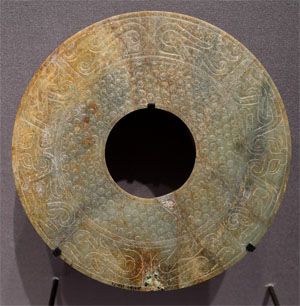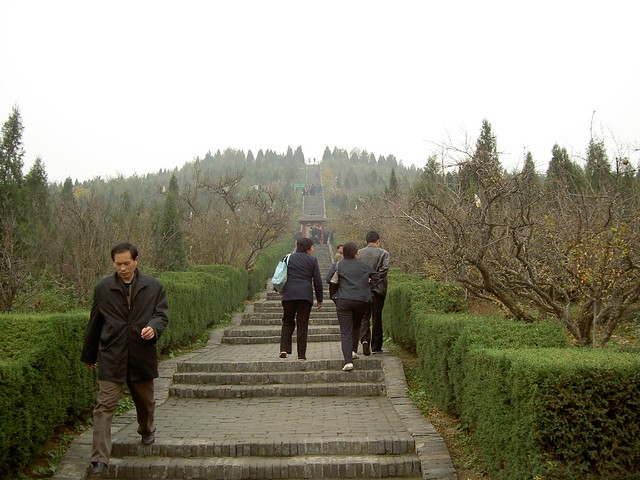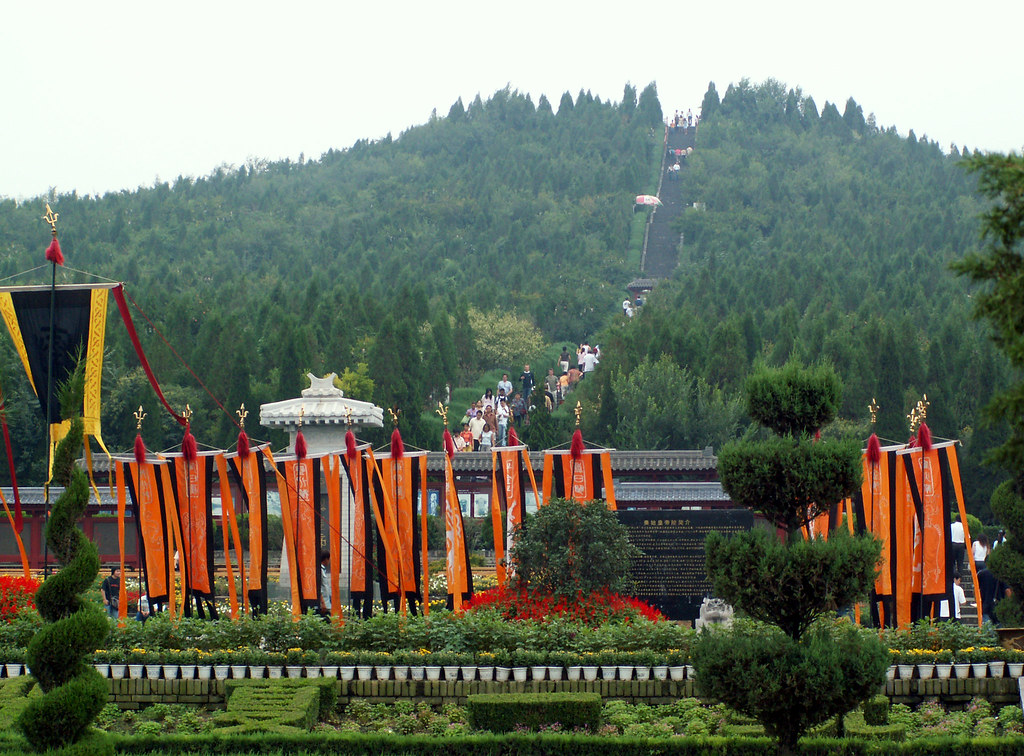Qin Shi Huang began construction of his tomb complex in 246 BC in Xi’an Shaanxi China. Following Emperor Huang’s conquest of all 6 states of China in 221 BC, construction picked up grew to a scale comparable to few places in the world.
The site is best known for the Terracota Warriors, a collection of 8,000 statue men with horses, weapons, and artifacts. These famous figurines were intended to guard and help the emperor with all of his needs for the afterlife, following the Egyptian tradition of burial. Each figure was crafted to an individual image from assembly molds and given bright painted colors and weapons. Rebel Xiang Yu plundered some of the 6m deep pits soon after their construction. Several pits of figurines have yet to be excavated.
But the real treasure is in the earthen mound nearby which this army guards. The entire necropolis covers 19 miles², with outer walls 6km long and inner walls 2.5km long of rammed earth. The only record of what is inside the man-made pyramid comes from Sima Qian’s Shiji, written a century later:
“In the ninth month, the First Emperor was interred at Mount Li. When the First Emperor first came to the throne, the digging and preparation work began at Mount Li. Later, when he had unified his empire, 700,000 men were sent there from all over his empire. They dug through three layers of groundwater, and poured in bronze for the outer coffin. Palaces and scenic towers for a hundred officials were constructed, and the tomb was filled with rare artifacts and wonderful treasure. Craftsmen were ordered to make crossbows and arrows primed to shoot at anyone who enters the tomb. Mercury was used to simulate the hundred rivers, the Yangtze and Yellow River, and the great sea, and set to flow mechanically. Above were representation of the heavenly constellations, below, the features of the land. Candles were made from fat of “man-fish”, which is calculated to burn and not extinguish for a long time.
The Second Emperor said: “It would be inappropriate for the concubines of the late emperor who have no sons to be out free”, ordered that they should accompany the dead, and a great many died. After the burial, it was suggested that it would be a serious breach if the craftsmen who constructed the mechanical devices and knew of its treasures were to divulge those secrets. Therefore after the funeral ceremonies had completed and the treasures hidden away, the inner gates were blocked, and the outer gate lowered, immediately trapping all the workers and craftsmen inside. None could escape. Trees and vegetations were then planted on the tomb mound such that it resembles a hill.” 1
Rivers of mercury may still flow in a miniature map of the kingdom in the tomb with sparkling stars overhead. It is not yet excavated so we don’t know. But even more may be found inside. The pyramid represents both the kingdom and the universe as a whole. The four sides represent the four directions and four corners of the earth, as indicated by Qin Shihuang’s inscription at Mount Langya:
“The Emperor in his wisdom
Inspects all four quarters of his realm;
High and low, noble and humble…
Great is the virtue of our Emperor
Who pacifies all four corners of the earth…
The universe entire
Is our Emperor’s realm,
Extending west to the Desert,
South to where the houses face north,
East to the East Ocean,
North to beyond Dahsia;
Wherever human life is found.” 2
Despite the praise in this poem, it is understood from Sima Qian’s record that Emperor Qin was a merciless tyrant who was responsible for the deaths of hundreds of thousands who constructed the mausoleum, the Great Wall, and other construction projects. He died a painful death in 210 BC due to mercury pills he consumed in an attempt to attain immortality and buried at Mt. Li because of its gold and jade mines.
| The Western influence on the terracotta statues is shocking. Their Hellenistic style is nothing like Chinese figures in the past. But the design and details of the entire complex seems to go beyond Greece to Egyptian roots. A ceremonial shu mace with a triangular head was used in animal sacrifice, much like the ceremonial maces Egyptians used in ceremony.
The Bi Disc found near the mausoleum has the same proportions as the Pantheon in Rome, Stonehenge, and the Aztec calendar.”It is found that these objects testify to… the notion of a covering sky (gaitian) that revolves around a central axis, the cycle of the Ten Suns, and the use of an early form of the carpenter’s square.” 3 Other earthen pyramids around China are as of yet unexcavated. |
 (Firedrop– wikipedia/creative commons license) |

(Haldini– flickr/creative commons license)

(ShashiBellamkonda– flickr/creative commons license)

(travelourplanet.com– flickr/creative commons license)
Sources:
^on en.Wikipedia.org: 司马迁 (1982). 史记. 卷六.秦始皇本纪: 中华书局, and Chinese Text Project, Shiji
^on wps.pearsoncustom.com: Sima Qian, The Records of the Grand Historian, trans. Yang Hsien-yi and Gladys Yang (Beijing, China: Foreign Language Press, 1979), pp. 169-72
^“The Original Significance of Bi Disks: insights based on Liangzhu Jade Bi with incised symbolic motifs”, by Shu-P’Ing, Teng, Journal of East Asian Archaeology Volume 2, Numbers 1-2, 2000 , pp. 165-194(30)

